In the first part of the Nepal Yathra series, we had covered the visit to Pashupatinath Temple in Kathmandu. On Day 2, we started to Pokhara from Kathmandu. Although there are flights available from Kathmandu and Pokhara, we took the road with a view to visit Manakamana Devi temple on the way.
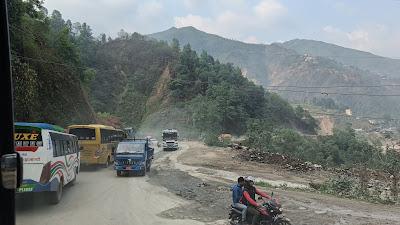
The bumpy ride from Kathmandu to Manakamana Devi Temple
The distance between Kathmandu and Pokhara is less than a hundred kilometres, it takes over five hours by road as there are road improvement works currently going on. However, our driver Manish steered the vehicle as smoothly as he could over the bumpy terrain, and our fellow travellers kept us in splits through their creative icebreaker session that we hardly noticed the longer than usual time it took us to reach the Manakamana Devi temple.
The temple is located at an altitude of 4300 ft (1300 metres) above sea level atop the Kafakdada hill in the Gorkha district of Nepal and can be reached via cable car from the Kurintar base station. The cable cars cross three hills to reach Kafakdada. Each cable car can house a maximum of 6 adults comfortably. Offering of animals is very common in Manakamana and therefore, there are open cages too that intersperse passenger cars, where these animals can be tied to and then received once the passengers reach the hill. Two rivers, Trishuli and Marsyangdi flow on either side of the Kafakdada Hill, and it is a pleasant sight to watch river Trishuli in flow as one goes up the cable car. None of the rivers in Nepal are clean and crystal clear. They are all muddy and murky, evidence to the massive construction work as well going on around and the dumping of different kinds of waste in the Himalayas by the trekkers about which we will see in a later article in this series.
Going downhill in the cable car over the Trishuli riverThe name Manakamana is self-explanatory. Mana refers to the heart and Kamana to desire. The Goddess is believed to fulfill genuine desires of her devotees, and hence they throng her temple in large numbers - particularly, newly wed couples and those seeking the boon of child birth, apart from tourists. There are several interesting studies that connect Nepal with Kerala. These studies speak about the Newaris of the Nepal becoming the Nairs of Kerala. Interestingly, the Goddess Parvati's incarnations are referred to in Nepal as Bhagawati, similar to the same name in Kerala. How Manakamana Bhagawati took her abode atop the Kafakdada hill is an interesting legend.
According to The History of Ancient and Medieval Nepal by D.B. Shreshtha & C.B. Singh, Purnendra Shah was the second Gorkha King who ruled for over 35 years. After his demise, his elder son Chatrapati Shah succeeded him. But not for long. Chatrapati Shah passed away without a heir within seven months of becoming the monarch and hence his younger brother Ram Shah became the ruler in 1606 CE. Ram Shah was a fair and conscientious monarch, who brought about many reforms in his State, such as uniform weights and measures, penal code, grazing lands in each village for cows, and standard rates of interest for borrowing. The Gorkha Palace was constructed by him in 1610 CE where his statue has been installed at the Chautari in the Gorkha Darbar where he would provide justice.
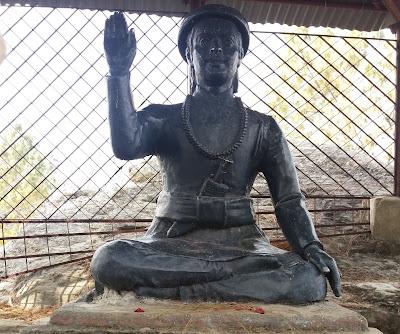
Statue of King Ram Shah at the Gorkha Durbar (Photo: Google)
According to an article by Dr Shapalya Amatya in the Ancient Nepal Journal, King Ram Shah's wife Champawati, possessed divine powers. These were recognised by a saint Siddha Lakhan Thapa (not to be confused with the first Martyr of Nepal of the same name, who is a descendant of the original Lakhan Thapa). One day, King Ram Shah had a vision of his wife as a Goddess and Siddha Lakhan Thapa as a lion, her vahana. When he spoke about this to Queen Champawati the next day, he was immediately overcome with a mysterious ailment to which he succumbed shortly.
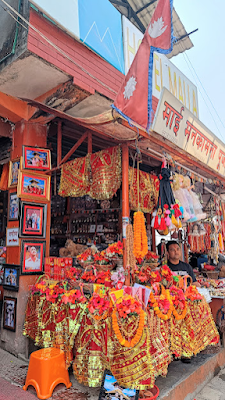
Shops selling Pooja Articles on the way to Manakamana Devi temple
The queen, as per the custom those days, got ready to perform Sati along with her husband. Unable to bear this, Lakhan Thapa was struck with grief and lamented loudly. The queen promised to him that she would return soon. During the reign of King Prithvipati Shah, a farmer named Dhan Deo Gurung was ploughing his field, when he hit upon a stone. When he unearthed it, he saw blood and milk flowing from it. The news reached Lakhan Thapa. When he arrived at the spot, the flowing of blood and milk stopped and he started worshipping the goddess at the spot where she had reappeared. Even today, it is the descendants of Lakhan Thapa who perform tantric worship to Goddess Manakamana Devi.
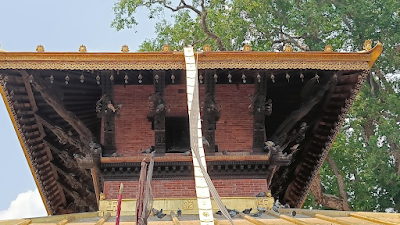
Closer look of the structure of Manakamana Devi Temple
The sanctum sanctorum contains five non-iconic rocks that symbolise Manakamana Devi, Bhairava, Ganesha, Kumari and Chamunda. The deities are placed under a triangular pediment supported by silver covered pillars. The priest performs worship under closed doors with offerings of eggs, oranges, rice, Kumkum and strips of cloth. Animal sacrifices happen every day except for Ekadashi and Amavasya.
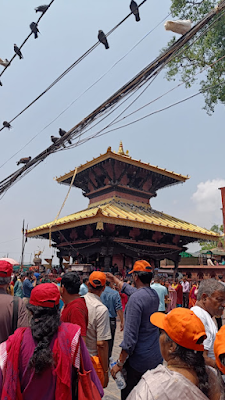
Outside the Manakamana Devi Temple
The building has a two tiered roof with golden mirrors and a central pinnacle with the sanctum facing the South. There are huge crowds that throng the temple each day, particularly after the cable car was introduced. A large courtyard is seen outside the temple, where hundreds of pigeons are seen. When we visited Manakamana Devi temple, the serpentine queue was very long and it was impossible for us to have waited in it to worship the Devi, given that we had to get to Pokhara before it became dark. So after reluctantly attempting to get a glimpse of the deity, which we could, we satisfied ourselves with worshipping the Bali Peeta outside and obtained Kumkum from those coming out of the temple. '
The picturesque cable car ride over the Trishuli river and the beautiful and divine ambience of the temple are indeed visit worthy. An official photographer is around to click pictures as people board the cable cars which do not actually stop! One has to get in and alight while the cars are in motion. After coming back to the base station, the prints are available for sale.
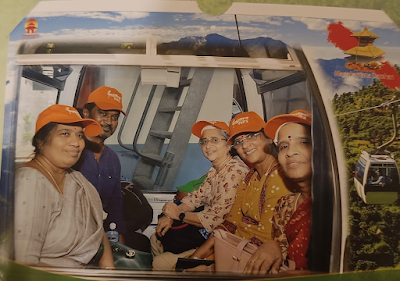
Cable car memories
